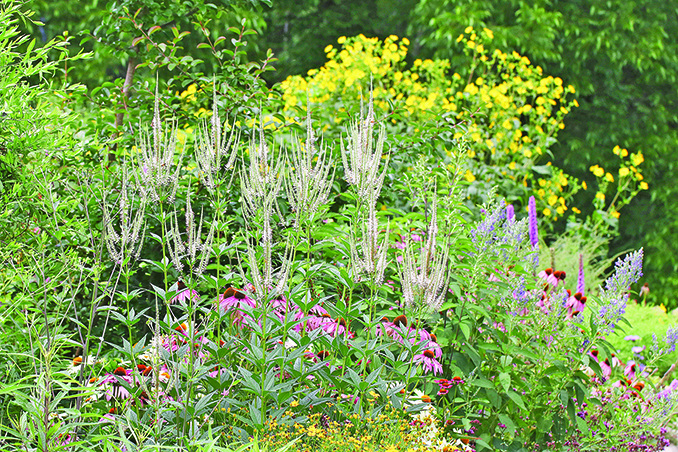Does your idea of the perfect garden include abundant plants that thrive with relatively little human intervention? Do they attract and support all kinds of pollinators? Sounds like a dream. And you can make it real by planting native plants. Native plants don’t need a lot of extra watering or fertilizing because they are already growing in the conditions they’re adapted to. Likewise they provide food for native insects and birds. Planting non-native plants can create a food desert for native pollinators. Check with your county’s cooperative extension office or other online resources to find out which plants are native in your area.
Picture this: You step into your garden, and the beds are brimming with flowers that thrive on benign neglect.
You seldom need to water them, and they don’t require much in the way of fertilizer, either. What’s more, you feel like Snow White as birds, bees and butterflies congregate around you, eating seeds and gathering pollen.
It feels like a dream, but it doesn’t have to be. If your idea of the perfect garden includes abundant plants that do well with little human intervention, while attracting and supporting all manner of pollinators, you can make it real by planting native plants.
The first step is to lure pollinators, which are necessary for the production of flowers, fruits and vegetables. The best way to attract them is by using plants that support them.
Our native insects and birds evolved alongside our native plants, so they naturally recognize them as food. Non-native species – exotic plants from Asia, Africa, South America and Europe and, to some degree, from distant regions of the U.S. – are simply not recognized as food sources by native pollinators. Planting them creates food deserts for native bees, birds, bats, butterflies, moths and beetles, all of which are necessary for a healthy ecosystem.
Doug Tallamy, a professor of entomology at the University of Delaware and author of “Bringing Nature Home: How You Can Sustain Wildlife with Native Plants” (Timber Press, 2007), found that non-native plant species disrupt the food chain, which can lead to a collapse of the ecosystem.
“Plant choice matters,” he said. “The plants we choose to landscape our properties (with) should be determined by how much life can live there.”
If you think about it, our lives depend entirely on insects: Without them, we would have no flowering plants, which would dismantle the food web that supports vital animals. Birds, for instance, depend on plants for food and disperse their seeds while keeping the populations of harmful insect in check.
Insects support plants that provide oxygen, clean our water, capture carbon and add it to the soil to enrich it. That builds topsoil and prevents flooding. Without them, the biosphere – the living portion of the earth, which includes soil – would rot, due to the loss of insect decomposers, and humans simply couldn’t survive that, Tallamy says.
In addition to providing food and habitat for insects and other wildlife, native plants are perfectly acclimated to growing in your region — so they don’t require much maintenance.
That means less watering, less fertilizing, less fussing. They’ve been doing quite nicely growing wild by the side of the road, thank you, and will do the same in your backyard.
The good news is we get to decide what we plant in our own gardens. So as we celebrate the 52nd anniversary of the first Earth Day on April 22, let’s resolve to plant more natives.

